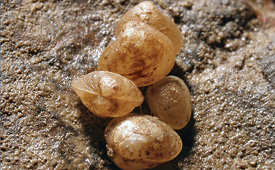Cryptic comments seem to have an ambiguous, obscure or hidden meaning. In biology, cryptic species are outwardly indistinguishable groups whose differences are hidden inside their genes.
Two U-M marine biologists have identified three cryptic species of tiny clams, long believed to be members of the same species, which have been hiding in plain view along the rocky shores of southern Australia for millions of years.

A closeup of L. australis clams from the southern Australia coast. Each clam is about the size of a rice grain. Photo by Denis Riek.
The unusual convergence of a climate-cooling event and the peculiarities of local geography caused the three cryptic species to split from a common ancestor more than 10 million years ago, the U-M researchers propose in a paper to be published next month in the journal Molecular Ecology.
The U-M scientists conducted a genetic analysis after collecting thousands of the crevice-dwelling, rice grain-sized clams from hundreds of miles of southern Australia coastline over the past decade. Their findings provide insights about the forces that shape evolution and solve a puzzle that has stumped marine biologists for decades.
“This study provides important clues about how marine regional biotas can evolve, including our observation that these processes can involve major global climate change modulated by local geography,” said Jingchun Li, lead author of the report and a doctoral student in the Department of Ecology and Evolutionary Biology.
Li conducted the research as part of her dissertation with co-author Diarmaid O’Foighil, Li’s adviser and director of the U-M Museum of Zoology.
“You cannot tell them apart physically, but their genes indicate that their evolutionary divergence predates that of humans from chimpanzees,” O’Foighil said of the three clam groups, which are currently classified as members of the same species, Lasaea australis.
Australia’s southern coastline is home to three evolutionarily distinct assemblages of marine species known as biogeographic provinces. Each province contains hundreds of species of invertebrates, fish, algae and other organisms, and there are substantial differences between the species living in each province.
In their study, Li and O’Foighil showed that each of the three cryptic clam species is found in only one of the three biogeographic provinces.
“I know of no other case where you start out with one marine biota, then a climate-change event results in the generation of three biotas from that one,” O’Foighil said. “A key finding of the study is that relatively ancient climate-change events can shape marine biotas.”

